Bhushan B. Nanotribology and Nanomechanics: An Introduction
Подождите немного. Документ загружается.

13 Computer Simulations of Nanometer-Scale Indentation and Friction 697
case the stick-slip was over a much longer length scale and may be due to the fact
that the surfaces were not hydrogen-terminated.
Mulliah et al. [210] used MD simulations with bond-order potentials [211] to
model interactions between indenter atoms, EAM potentials [212] to model interac-
tions between substrate atoms, and the Ziegler–Biersack–Littmack potential [213]
to model interactions between indenter and substrate atoms to study the atomic-
scale stick-slip phenomenon of a pyramidal diamond tip interacting with a silver
surface at several sliding rates and vertical support displacements. These simulat-
ions showed that dislocations are related to the stick events emitting a dislocation in
the substrate near the tip. The scratch in the substrate is discrete due to the tip jump-
ing over the surface in the case of small vertical displacements. In contrast, large
displacements of 15Å or more result in a continuous scratch. These simulations
also showed how the dynamic friction coefficient and the static friction coefficient
increase with increasing tip depth. The tip moves continuously through a stick and
slip motion at large depths,whereas it comes to a halt in the case of shallow indents.
Although the sliding rate can change the exact points of stick and slip, the range of
sliding rates over the range of values considered in this study (1.0 to 5.0m/s) has
no influence on the damage to the substrate, the atomistic stick-slip mechanisms, or
the calculated friction coefficients.
The effect of the way in which the tip is rastered across the surface in MD
simulationswas consideredby Cai and Wang[209,214]using bond-orderpotentials.
In particular, they dragged silicon tips across several silicon surfaces, as illustrated
in Fig. 13.41, in two different ways. In the first, they moved the tip every MD step
while in the other they advanced the tip every 1000 steps. In both cases, the overall
sliding rate is the same and equals 1.67m/s. In both cases, wear of the tip such as is
illustrated in Fig. 13.41 occurs. However, the mechanisms by which the wear occurs
are found to depend on the approach used, and the latter approach is found to be in
better agreement with experimental data.
In many studies, diamond tips or diamond-decorated tips are used in friction
measurements. Diamond is an attractive material for an FFM tip because of its high
mechanical strength and the belief that such tips are wear-resistant. However, dia-
mond tips that were used to scratch diamond and silicon surfaces and then imaged
showed significant wear that increased with the increasing hardness of the tested
material [215,216]. This wear altered the shape of the tip and hence influenced the
contact area that is used to determine friction coefficients.
In summary, MD simulations provide insight into dry sliding friction and the
sliding of metal tips across clean metal, crystalline ceramics, and layered ceramics
surfaces. Stick-slip friction or wear can occur depending on the sliding conditions.
The good lubricating properties of layered ceramics are observed in the simulations
along with localized fluctuations in atomic-scale friction. Crystalline ceramics, such
as diamond, exhibit relatively low friction and the simulations show how stick-slip
atomic-scale motion changes with the conditions of sliding and the way in which
the simulation is performed.
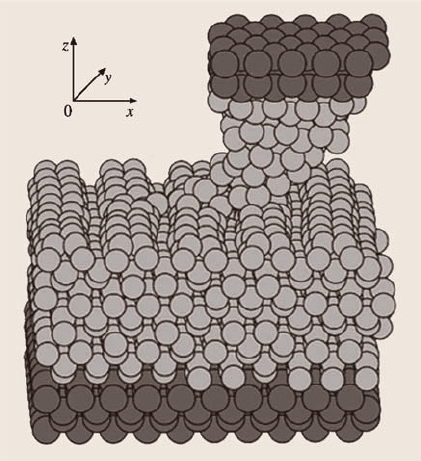
698 Susan B. Sinnott et al.
Fig. 13.41. Snapshots of
a Si(111) tip interacting with
a Si(001) 2×1 surface. The tip
is rastering along the surface
in the x-direction and starts
off at a distance of 9 Å from
the surface. After [209] with
the permission of the CCLRC
(2002)
13.4.2 Decorated Surfaces
While dry sliding friction in vacuum assumes that ambient gas particles have no
direct effect on the results, MD simulations show that free particles between two
surfaces in sliding contact influence friction to a surprisinglylarge degree.These so-
called third-body molecules have been studied extensively by Perry et al. [177,217,
218] using MD simulations with bond-order and LJ potentials. These simulations
focus on the effect of trapped small hydrocarbon molecules on the atomic-scale
friction of two (111) crystal faces of diamond with hydrogen termination. These
molecules might represent hydrocarbon contamination trapped between contacting
surfaces prior to a sliding experiment in dry friction, or hydrocarbon debris formed
during sliding.
In particular, the effects on friction of methane (CH
4
), ethane (C
2
H
6
), and isobu-
tane (CH
3
)
3
CH trappedbetween diamond (111) surfacesin sliding contact were ex-
amined in separate studies (Fig. 13.42). The frictional force for all these systems
generally increases as the load increases, as illustrated in Fig. 13.43. The simulat-
ions predict that the third-body molecules markedly reduce the average frictional
force compared to the results for pristine hydrogen-terminatedsurfaces. This is par-
ticularly true at high loads, where the third-body molecules act as a boundary layer
between the two diamond surfaces. That is, the third-body molecules reduce the in-
teraction of hydrogen atoms on opposing surfaces [218]. This is demonstrated by
examining the vibrational energy excited in the diamond lattice during the sliding
(Fig. 13.44). Significant vibrational excitation of the diamond outer layer (C–H) oc-
curs inthe absence ofthe methanemolecules.Thus, the friction isapproximately3.5
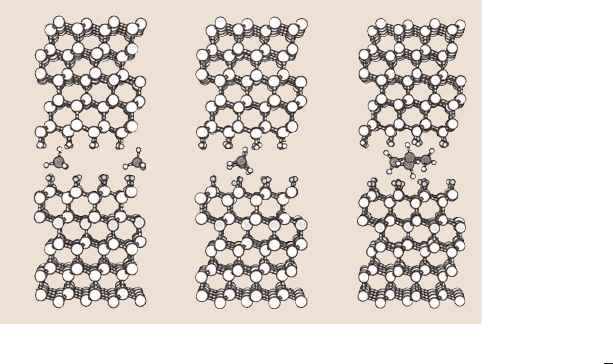
13 Computer Simulations of Nanometer-Scale Indentation and Friction 699
a) b) c)
Fig. 13.42a–c. Initial configuration at low load for the diamond plus third-body molecule
systems. These systems are composed of two diamond surfaces, viewed along the [
110] di-
rection, and two methane molecules in (a), one ethane molecule in (b), and one isobutane
molecule in (c). Large white and dark gray spheres represent carbon atoms of the diamond
surfaces and the third-body molecules, respectively. Small gray spheres represent hydrogen
atoms of the lower diamond surface. Hydrogen atoms of the upper diamond surface and the
third-body molecules are both represented by small white spheres. Sliding is achieved by
moving the rigid layers of the upper surface from left to right in the figure. After [177] with
the permission of the ACS (1997)
times larger when methane is not present. The application of load to the diamond
surfaces causes the normal mode vibrations of the trapped methane molecules to
change. Power spectra calculated from MD simulations [217,218] show that even
under low loads, the peaks in the power spectra are significantly broadened. Peaks
in the low-energy region of the spectrum almost disappear with the additional ap-
plication of load.
The size of the methane molecules allows them to be “pushed” in-between hy-
drogen atoms on the diamond surfaces while sliding [218]. However, steric con-
siderations cause the larger ethane and isobutane molecules to change orientation
during sliding. Conformations that lead to increased interactions with the diamond
surfaces increase the average frictional force. Thus, despite the fact that the two dia-
mond surfaces are farther apart when ethane and isobutane are present compared to
when methane is present, the friction is larger because these molecules do not “fit”
nicely into potential energy valleys between hydrogen atoms when sliding.
When similar hydrocarbon molecules (methyl, ethyl, and n-propyl groups) are
chemisorbed to one of the sliding diamond surfaces, instead of trapped between
the surfaces, different behavior is observed by Harrison et al. [172,173,208,219].
Simulations show that methyl-termination does not decrease friction significantly
but results in frictional forces that are nearly the same as they are for hydrogen-
terminated diamond surfaces [207]. While the methane third-body molecules de-
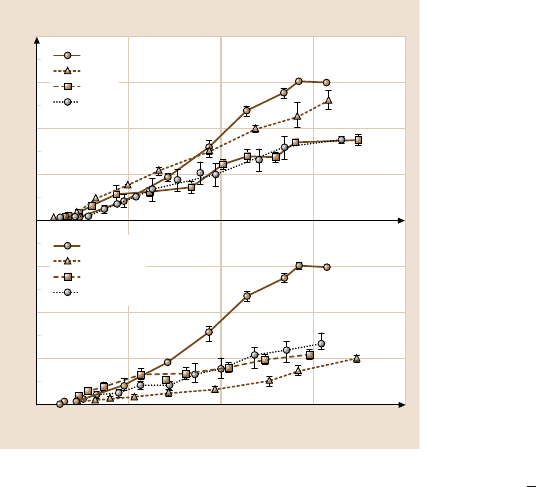
700 Susan B. Sinnott et al.
0
0
Average normal load (nN/atom)
Average frictional force (nN/atom)
0.1
0.2
0.3
0
0.1
0.2
0.3
0.4
10.25 0.5 0.75
H
C
2
H
6
CH
4
(CH
3
)
3
CH
H
C
2
H
5
CH
3
C
3
H
7
Fig. 13.43. Average frictional force per rigid-layer atom as a function of average normal
load per rigid-layer atom for sliding the upper diamond surface in the [11
2] crystallographic
direction. Data for the methane (CH
4
)system(open triangles), the ethane (C
2
H
6
)system
(open squares), the isobutane (CH
3
)
3
CH system (filled circles), and diamond surfaces in
the absence of third-body molecules (open circles) are shown in the lower panel. Data for
the methyl-terminated −CH
3
system (open triangles), the ethyl-terminated (−C
2
H
5
)system
(open squares), the n-propyl-terminated (−C
3
H
7
)system(filled circles), and diamond sur-
faces in the absence of third-body molecules (open circles)areshownintheupper panel.
Lines have been drawn to aid the eye. After [177] with the permission of the ACS (1997)
crease the frictional force to a greater extent than the chemisorbed methyl groups,
friction as a function of load is comparable for the ethyl-terminated and ethane sys-
tems, with the former giving slightly higher frictional forces. Attaching the hydro-
carbon groups to the diamond surfaces causes them to have less freedom to move
between hydrogen atoms on opposing diamond surfaces during sliding. This gener-
ally increases their repulsive interaction with the diamond counterface.
MD simulations can also provide insight into the rich, nonequilibrium tribo-
chemistry that occurs between surfaces in sliding contact. Harrison and Brenner
examined the tribochemistry that occurs when ethane molecules are trapped be-
tween diamond surfaces in sliding contact, as illustrated in Fig. 13.45 [220]. This
simulation was the first to show the atomic-scale mechanisms for the degradation
of lubricant molecules due to friction. The type of debris formed during the sliding
simulation is similar to the types of debris molecules that were observed in macro-
scopic experiments that examined the friction between diamond surfaces [221].
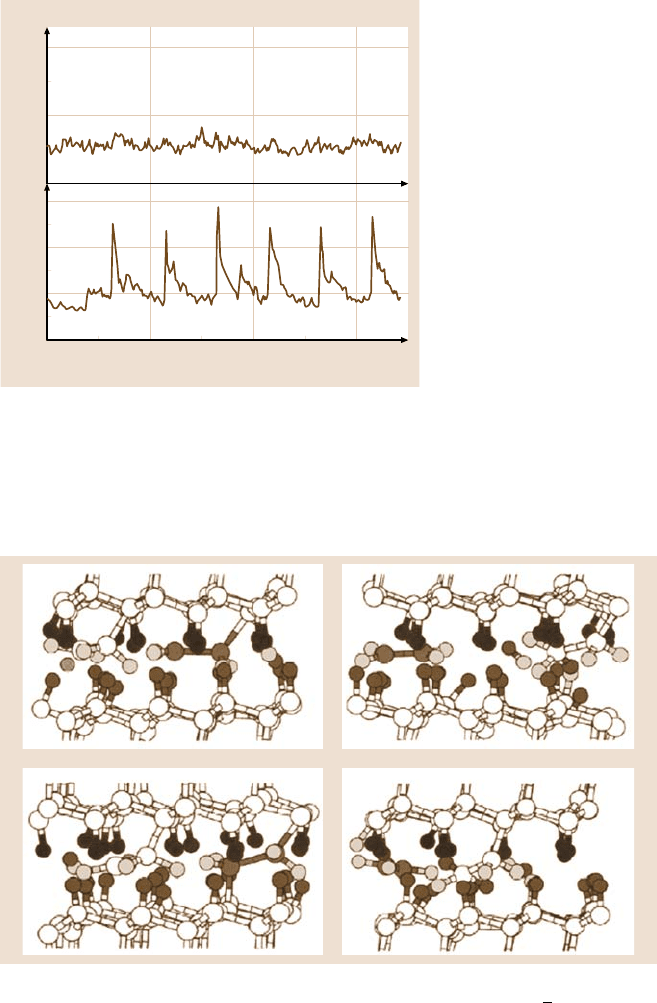
13 Computer Simulations of Nanometer-Scale Indentation and Friction 701
0
0
Sliding distance/unit cell
Vibrational energy (K)
500
1000
1500
0
1000
500
2 4 6
H
CH
4
Fig. 13.44. Average vibrational energy between the (C–H) bonds of the upper diamond (111)
surface versus sliding distance for hydrogen-terminated diamond (111) surfaces, with (CH
4
)
and without methane (H), trapped between them. The average normal load is approximately
the same in both simulations and is in the range 0.8–0.85 nN/atom. The average frictional
force on the upper surface is about 3.5 times smaller in the presence of the methane third-body
molecules. After [218] with the permission of Elsevier (1996)
a) c)
b) d)
Fig. 13.45a–d. Snapshots from a molecular dynamics simulation of the sliding of two
hydrogen-terminated diamond (111) surfaces against one another in the [11
2] direction. The
upper surface has two ethyl fragments chemisorbed to it. The simulation shows how sliding
can induce chemistry at the interface. After [220] with the permission of the ACS (1994)
702 Susan B. Sinnott et al.
In the case of sliding metal surfaces, impurity molecules or atoms (both ad-
sorbed and absorbed) on thin metal films can be expected to affect the film’s proper-
ties. For example, calculations have shown that resistivity changes in the metal are
strongly dependent on the nature of the adsorption bond [222]. When this result is
used to interpret atomic-scale friction results obtained with the QCM, the sliding of
adsorbate structures on metal surfaces are shown to be a combination of electron
excitation and lattice vibrations. Additionally, other interesting quantum effects can
come into play when the adsorbate is very different chemically from the surface on
which it is sliding. For instance, the electronic frictional forces acting on small, inert
atoms and molecules, such as C
2
H
6
and Xe, sliding on metal surfaces have been cal-
culated by Persson [223], where the metal surface was approximated by a electron
gas (jellium) model. The calculations showed that the Pauli repulsive and attractive
vander Waals forcesare of similar magnitudes. In addition,the calculated electronic
friction contributions agree well with the values derived from surface resistivity by
Grabhorn et al. [224] and QCM measurements. These studies showed that parallel
friction is mainly due to electronic effects while perpendicular friction is phononic
in nature in this system.
In summary, MD simulations show that the average frictional force decreases
significantly in systems with third-body molecules, especially at high loads. Simu-
lations also provide information about the details of tribochemical interactions that
can occur between lubricants and sliding surfaces. Additionally, the effect of the
presence of small molecules on thin metal films can influence film properties, such
as resistivity.
13.4.3 Thin Films
As discussed at the beginning of this section, the conversion of the work of sliding
into some other less ordered form is responsible for friction at sliding solid inter-
faces. In the case of adhering systems, the work of sliding may be converted into
damage within the bulk (plastic deformation), while in the case of weakly adhesive
forces, friction can occur through the conversion of work to heat at the interface
that causes no permanent damage to the surface (wearless friction). The latter case,
when it is achieved throughthe presence of lubricatingthin films, is the topic of this
section.
There are several types of lubricatingthin films, the simplest of which consist of
small moleculesthat are analogousto wear debris that can “roll”between the sliding
surfaces or that represent very short-chain bonded lubricants. These thin films were
discussed in the previous subsection. The rest of this subsection will, therefore,
focus on the effects of liquids, larger nanoparticles, self-assembled monolayers and
solid thin films on lubrication and friction.
Liquids
Liquids are common lubricants and so they have been studied in great depth at the
macroscale.At the nanoscale,the tribologicalresponseof sphericalliquidmolecules
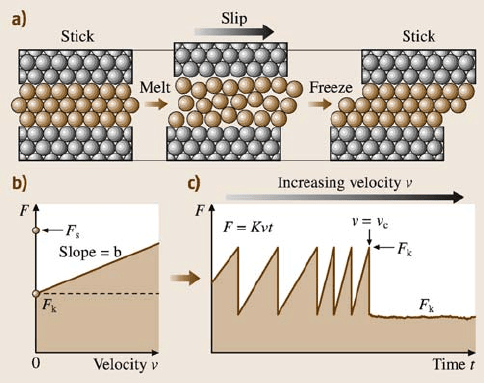
13 Computer Simulations of Nanometer-Scale Indentation and Friction 703
Fig. 13.46a–c. Thestick/sliptransitionthatoccurs for thinfilms of liquid between two sliding
solid surfaces. F is the intrinsic friction and F
s
is the friction where the liquid is in the
rigid state; F
k
is the friction where the liquid is in the liquid-like state. After [225] with the
permission of the ACS (1996)
has been well-characterizedexperimentallyusing the SFA and computationally with
MD simulations by Berman et al. [225]. The SFA experiments considered one to
three liquid layers and the stick-slip motion at the interface is found to increase in
a quantized fashion as the number of lubricant layers decrease. When no external
forcesare appliedto thesystem,the slidingstops andthe solid–lubricantinteractions
are strong enough to force the liquid molecules to form a close-packed structure
that is ordered. The transformation of the liquid into this solid-like structure causes
the two surfaces to effectively bond to each other through the lubricant. When the
surfaces startto slide again,lateral shear forces are introducedthat steadily increase,
which causes the molecules in the liquid to undergosmall lateral displacements that
change the film thickness. If these shear forces become greater than a critical value,
the film disorders in a manner that is analogous to melting. This allows the surfaces
to slide easily past each other in a manner that is still quantized. This sequence of
events is nicely illustrated in Fig. 13.46 and can be reproduced multiple times for
the same system.
Persson et al. [226] used MD simulations with pairwise potentials similar to
those in (13.6) to examine the mechanism by which this sharp transition occurs.
They find that in the case of sliding on insulating crystal surfaces, the solid-state
lubricant may be in a “superlubric” state where the friction is negligible. It is clear
from the simulations, however, that any surface defects, even in low concentrations,
will disrupt this state and transform the lubricantback into a fluid. In addition,when
sliding occurs on metallic surfaces above cryogenic temperatures, the electronic
contributions to friction are no longer zero and no superlubric state is possible.
704 Susan B. Sinnott et al.
High applied pressures can force the fluid molecules out from between the two
confining surfaces [227]. The fact that liquid molecules close to a stiff surface are
strongly layered in the direction perpendicular to the surface explains the experi-
mental observation of a (n → n−1) layer transition, where n is number of monolay-
ers, that is observed as the normal load increases [228]. Nucleation theory is used to
calculate the critical pressure and determine the spreading dynamics of the (n−1)
island.
The reactivity of the liquid molecules are also critically important to boundary
layer friction. MD studies by Persson et al. [229] show that inert molecules inter-
act weakly with sliding surfaces. Consequently, as the rate of sliding increases, the
molecular conversion from the solid state to the liquid state occurs in an abrupt
manner. However, when the molecules interact strongly with the surfaces, they un-
dergo a more gradual transition from the solid to the liquid state. Persson et al. [34]
also considered systems where the molecules are attached to one of the surfaces,
which causes the transitions to be abrupt. This is especially true if there are large
separations between the chains.
While the studies discussed so far have focused on spherical liquids, most
widely used liquid lubricants consist of long-chain hydrocarbons.Nonspherical liq-
uid moleculeshavemore difficultyaligning and solidifying. Thisis borneout in MD
simulationsby Thompsonet al. [231] that show that sphericalmoleculeshavehigher
critical velocities than branched molecules. In particular, the simulations show that
when the molecules are branched, the amount of time various parts of the system
spend in the sticking and sliding modes changes with sliding rate. The critical ve-
locity can also depend on the number of liquid layers in the film, the structure and
relative orientation of the two sliding surfaces, the applied load and the stiffness of
the surfaces.
Additional studies by Landman et al. [230] used MD simulations with bond-
order and EAM potentials coupled with pair-wise potentials similar to (13.6) to
study the sliding of two gold surfaces with pyramidal asperities that have straight
chain C
16
H
34
lubricant molecules trapped between them, as illustrated in Fig. 13.47.
An important aspect of this study is that the sliding rate in the simulations is about
10m/s, which is the same order of magnitude as the scanning speed in a computer
disk. As the asperities approach each other, the hydrocarbon molecules begin to
form layers. This is reflected in the oscillations in the frictional force shown in
Fig. 13.48. When the asperities overlap in height and approach each other laterally,
the pressure of the lubricant molecules increases to about 4 GPa which leads to the
deformation of the gold asperities.
Glosli and McClelland [174] modeled the sliding of two ordered monolayers
of alkane chains that are attached to two rigid substrates. This system is shown
schematically in Fig. 13.49. The simulations predicted that energy dissipation oc-
curs by a discontinuous plucking mechanism (sudden release of shear strain) or
a viscous mechanism (continuous collisions of atoms of opposite films). The spe-
cific mechanism that occurs depends on the interfacial interaction strength. In par-
ticular, the “pluck” occurs when mechanicalenergy stored as strain is convertedinto
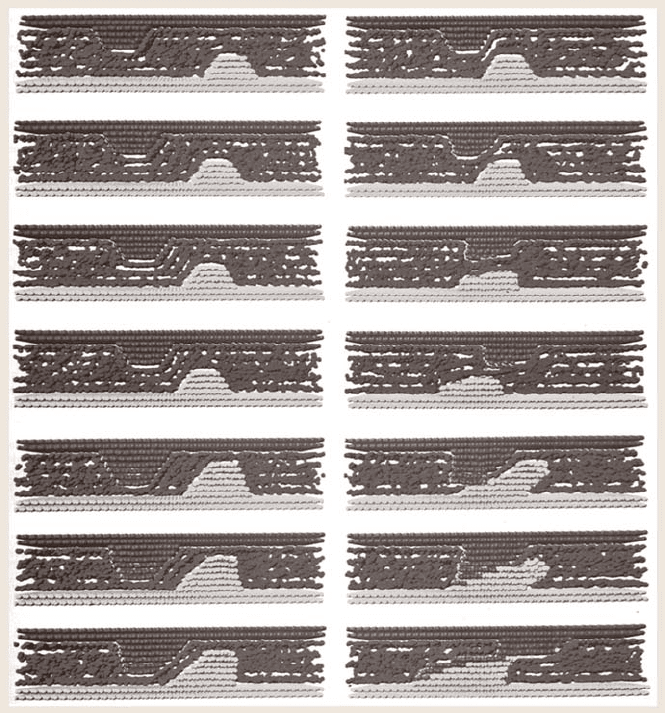
13 Computer Simulations of Nanometer-Scale Indentation and Friction 705
Fig. 13.47. Stills from a molecular dynamics simulation where Au(111) surfaces with surface
roughness slide over one another while separated by hexadecane molecules. The scanning
velocity is 10 m/s. Layering of the lubricant and asperity deformation occurs as the sliding
continues. The top three rows show the results when the asperity heights are separated by
4.6Å.Thebottom three rows show the results when the asperity heights are separated by
−6.7 Å. After [230] with the permission of the ACS (1996)
thermal energy that leads to low friction forces at low temperatures. On the other
hand, at higher temperatures some of the energy of sliding is dissipated through
phonon excitations, which results in higherfrictional forces. Interestingly, this trend
reverses again at the highest temperatures considered when the molecules move so
much that they slide easily over the surfaces, which decreases the frictional force.
These results are summarized in Figs. 13.50 and 13.51.
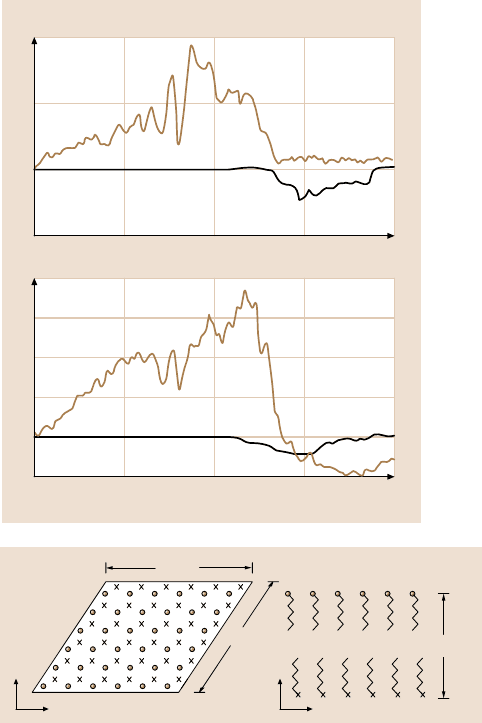
706 Susan B. Sinnott et al.
0
5
t (ps)
F
z
(nN)
0
5
10
15
20
1000250 500 750
5
F
x
(nN)
10
0
5
6
54
3
2
a)
b)
Fig. 13.48a,b. The lateral
force (F
x
) and normal force
(F
z
) from the molecular dy-
namics simulations shown in
Fig. 13.35 as a function of
time. The forces between the
two metal surfaces are shown
by the dashed line. The force
oscillations correspond to
the structural changes of the
lubricant in Fig. 13.35. Af-
ter [230] with the permission
of the ACS (1996)
20.7Å
x
y
x
z
20.7Å
20.43 Å
Fig. 13.49. Top andside views of the alkane chains attached to surfaces that are sliding against
each other. After [174] with the permission of the APS (1993)
Other studies of sliding surfaces with attached organicchains include MD simu-
lations with LJ potentials by Müser and coworkers, [41,232,233]which considered
friction between polymer “brushes” in sliding contact with one another. In particu-
lar, they considered the effect of sliding rate on the tilting of polymers and the effect
of steady-state sliding versus non-steady-state(“transient”)sliding. The simulations
find that shear forces are lower for chains that tilt in a direction that is parallel to the
shear direction. This tilting effect is significant for grafted polymers, as illustrated in
Fig. 13.52, and less significant for absorbed polymers. This is due to the decrease in
the differential frictional coefficient for the grafted polymers as well as the increase
in the friction coefficient for absorbed polymers under shear. The tilting is also af-
